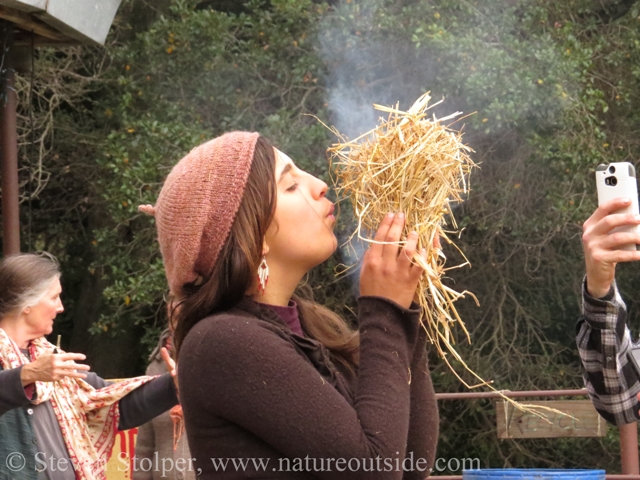And all the best for dry tinder in 2015.
A question for you, sir:
I have been carving lots of western red cedar for years.
As you know, the ring count, the number of annual growth rings per inch, varies a lot.
I see from maybe 8/inch to above 50/inch. For my wood carving, less than 20 is too soft and punky.
Above 40 is harder than birch but still carves OK.
The cedar hearth board: were I to make one, which end of the ring count spectrum is best?
Hi
Robson Valley!
This is a very good question. I wish I could provide a good answer.
I personally use cedar only for bow drill, not for hand drill. When I use it for bow drill, I tend to use softer cedar. But I do so because it is what I have on hand. The interns at the bird sit used "softer" cedar for their hearthboard. They were able to notch the board using a relatively dull knife.
For bow drill, I don't choose cedar when I can get another type of wood. For me, cedar is a 7/10 on the difficulty scale compared to other woods available in my area such as mule fat/seep willow (Baccharis salicifolia).
When I taught bowdrill (not for a long time), I sometimes used cedar strips made for fence pickets for the hearthboards. I can find incense cedar and western red cedar at local DIY stores for a dollar or two. They are ready to be notched and used. This might be an inexpensive way for you to experiment and compare the results to denser samples left over from your carving.
I'm sorry I can't be of more help. But I think a little experimentation will go a long way.
I notice you are in BC. Here are some wood combinations used in the state of Washington, which is closer to you than I am. They may give you an idea of the relative densities of the cedar sapwood/heartwood used. I think the source of this information is trustworthy:
Successful Hand Drill Combinations of the Olympic Peninsula, WA
On Western Hemlock Root (Tsuga heterophylla)
Big-Leaf Maple (Acer macrophyllum)
Cattail (Typha latifolia)
Red Elderberry (Sambucus racemosa)
On Western Red Cedar heartwood (Thuja plicata)
Big-Leaf Maple (Acer macrophyllum)
Western Red Cedar (Thuja plicata)
Salmonberry (Rubus spectabilis)
Thimbleberry (Rubus parviflorus)
Canada Thistle (Cirsium arvense)
On Western Red Cedar sapwood (Thuja plicata)
Cattail (Typha latifolia)
Horseweed (Conyza canadensis)
Canada Thistle (Cirsium arvense)
Burdock (Arctium lappa)
Mullein (Verbascum thapsus)
On Sub-Alpine Fir (Abies lasiocarpa)
Spiraea (Spiraea latifolia)
Ocean Spray (Holodiscus discolor)
Western Red Cedar (Thuja plicata)
On Sitka Spruce (Picea sitchensis)
Bitter Cherry (Prunus emarginata)
Clematis (Clematis lingustifolia)
On Douglas Fir (Pseudotsuga menziesii)
Douglas Fir (Pseudotsuga menziesii)
Big-Leaf Maple (Acer macrophyllum)
Clematis (Clematis lingustifolia)
Cattail (Typha latifolia)
Western Red Cedar (Thuja plicata)
Red Elderberry (Sambucus racemosa)
On Big-Leaf Maple (Acer macrophyllum)
Big-Leaf Maple (Acer macrophyllum)
Cattail (Typha latifolia)
Ocean Spray (Holodiscus discolor)
Thimbleberry (Rubus parviflorus)
Salmonberry (Rubus spectabilis)
On Douglas Fir bark (Pseudotsuga menziesii)
Yarrow (Achillea millefolium)
On Scotch Broom (Cytisus scoparius)
Scotch Broom (Cytisus scoparius)
On Artist’s Conk fungus (Ganoderma applanatum)
Big-Leaf Maple (Acer macrophyllum)
Mullein (Verbascum thapsus)
On Red-Belted Conk fungus (Fomitopsis pinicola)
Big-Leaf Maple (Acer macrophyllum)
From:
http://www.primitiveways.com/Fire Making Materials.html
I hope this helps.
- Woodsorrel


